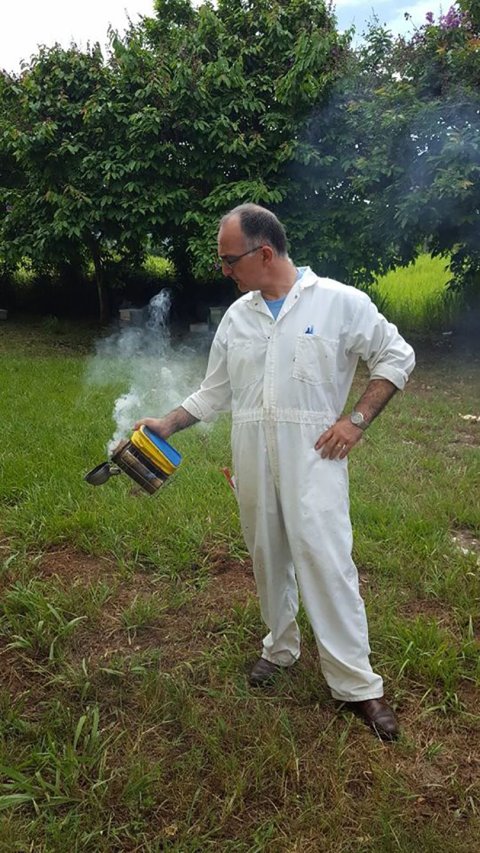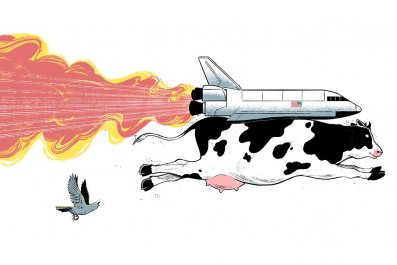It's a killer mystery without a killer. The astonishing die-off of honeybees over the past decade is a problem no one knows how to solve, but the key might rest in Puerto Rico, where the so-called "killer bee" spontaneously became gentle. This remarkable evolutionary leap could hold the secret to restoring the global bee population—unless Hurricane Maria kills off these benign "killers."
The strange story begins around 400 years ago. When European settlers came to the Americas in the 1600s, they brought their bee colonies. Because North America has a temperate climate similar to Europe's, the bees thrived there. But other settlers—and their bees—went to South America, which has a tropical climate. There, the bees grew weak and became vulnerable to parasites and disease.
For years, beekeepers wondered if the right genetic infusion could build a better bee in South America. In the 1950s, Brazilian researchers brought in a species of tropical bee from Africa that was carefully quarantined and introduced into an experimental breeding program.
The scheme both worked and didn't. "The catch was that they were tropically adapted and very strong, healthy, vigorous bees—but also very aggressive," Gene Robinson, director of the Illinois Bee Research Facility, tells Newsweek. "The scientists back then said, 'Well, we'll be able to control them, we'll carefully monitor and contain them and see whether we can diminish the aggression with selective breeding.'"
That was not to be. In 1956, 26 swarms of aggressive bees escaped from their quarantine and bred haphazardly with wild honeybees. This mixing resulted in what Robinson and colleagues describe in a recent paper as "the infamously aggressive, admixed, invasive, New World hybrid population of Africanized honeybees"—now commonly known as the killer bee. Before long, the hybrids expanded beyond Brazil. By 1985, they'd hit North America, and by the early 1990s, killer bee hives were being reported across southern Texas.

Killer bees are the suspected perpetrators of some horrific scenes. In 2013, 30,000 bees attacked a Texas couple and their miniature horses, stinging them hundreds of times and swarming over their bodies completely. The couple survived, but both horses died. "The spread [of these bees] is a major public health problem," University of Illinois crop sciences professor Matthew Hudson tells Newsweek. After what sounded like a worried pause, he adds, "They do sting people.… And if you run away, they'll follow you. Oh, they'll still die, yeah, but they'll all swarm you and follow you. And then they'll die."
The Do Bee
A few decades after the bees escaped from Brazil, their tale took a surprising turn. In 1994, a small founder population crossed the Caribbean (probably stowed away on a boat from Mexico) and made it to Puerto Rico. They infiltrated the domesticated colonies of European bees, toppled the queen and installed an Africanized one in her stead.
In the years that followed, beekeepers there noticed something very odd: These once-scary bees stopped attacking humans. In just 30 years, they made an evolutionary leap and became a strong, thriving honeybee population that was also gentle toward beekeepers. There is no other known instance of this happening anywhere else in the world.
Why this happened in Puerto Rico, but not in Mexico, Brazil, California, Texas or anywhere else, researchers don't know. The phenomenon seems to have appeared spontaneously.
Regardless of what prompted the Puerto Rican bees to take a big step up the evolutionary ladder, it happened just in time. Around 2005, worker bees all over the world began abandoning their colonies, for no apparent reason. The global honeybee population plummeted, which was grim news for bees and humans alike, since one-third of the human diet is made up of crops we rely on bees to pollinate. If honeybees go extinct and we don't have anything to replace them with, many foods we love could disappear too.
The gentle bees are remarkable, but only recently have researchers realized the full extent of their potential still wasn't even known. Robinson says that only in the past two decades have researchers realized that these gentle bees are still aggressive enough toward parasites to withstand a particularly nasty one called the Varroa mite.
Multiple causes of the die-off have been identified in the years since. One of the major causes, though, is the Varroa mite, which has been laying waste to honeybee populations across parts of North America. Not only do the mites spread disease; they're also big and hard for most bees to fight off. "This would be like having a cat on your back," says Robinson.
Robinson and other bee researchers began wondering whether the gentle Africanized bees could help save their bee brethren.

Gene Genies
To understand the underlying genetics of the Puerto Rican bee population, scientists in Illinois, Puerto Rico and elsewhere sequenced the genomes of 30 male drones from an Africanized killer bee population in Mexico; 30 from the European stock that settlers had brought to North America; and 30 from the gentle bee colonies on Puerto Rico. Because the killer bees that migrated there initially took so strongly after their African ancestors, the researchers expected to find a genome that reflected that heritage. But the researchers also found a few regions where the gentle bee genome looked European. Robinson and his team hypothesized that these regions contained the genes that were making the bees gentle. In November, a paper explaining their research was published in the scientific journal Nature Communications.
With this new information on the bee genome, scientists are closer to learning which genes make the Puerto Rican honeybees behave nicely toward humans. The researchers believe those bees went through what's known in genetics research as a "soft selective sweep." A hard selective sweep is a sudden change to the genome that occurs when one strong gene favored by natural selection takes over and wipes out weaker genes. This hard sweep results in a more uniform, less diverse genome, which can make the genome's owner vulnerable to disease, famine or other threats; genetic variation is what allows us to adapt to new circumstances and thus continue to survive.
But a soft sweep affects only a few specific regions of DNA. This alteration moves the genetic needle just enough that the trait in question does change, but not so much that its owner loses the benefits of a diverse genome. That's what the researchers think happened with the killer bees.
They don't know why. Robinson says the team's best guess is that these versions of the genes were in the founder population of bees that first came to Puerto Rico, just at very low frequencies. Once they arrived, something about the environment caused them to begin expressing the gentle-toward-humans gene variant at higher frequencies. Or it's possible that a mutation occurred in the population after they arrived. There's no way to know for sure.
Either way, the killer bees remained aggressive toward the mites but not toward humans, and by sequencing the honeybee genome, the research team showed that natural selection in Puerto Rico had uncoupled the two behaviors. One trait was able to evolve without affecting the other.
Robinson says the isolation of the mite-resistant trait means "we might be able to push for selection for creating strains resistant to mites and help fight colony collapse."
A bee that could withstand death by parasite could go a long way toward stopping colony decline. "Ask any beekeeper if they'd like to have access to a population of bees resistant to Varroa mites but also gentle and they'd be like, 'Hell, yeah.' That's the holy grail," says Amro Zayed, a geneticist and biologist at York University in Toronto who was not involved with the research. Researchers have tried using killer bees to fight mites, but their aggressiveness makes even simple steps, like loading them onto trucks, often more trouble than it's worth. Zayed agrees that the gentle killer genome might make that feasible. "If we better understand the circumstances where the bees naturally evolved gentleness and can re-create them, there's the potential to have our cake and eat it too."

Staying Alive With the Bee Genes
In September, after three years of research, the team was waiting to hear if their paper had been accepted for publication and looking forward to the next phase of their work. Then Hurricane Maria struck; it laid waste to Puerto Rico, leveling its infrastructure and causing the largest blackout in American history.
The Puerto Rican Department of Agriculture estimates that 80 percent of the island's 150,000 bee colonies disappeared in Maria's aftermath. Tugrul Giray, a biologist at the University of Puerto Rico and one of the co-authors of the new genomics paper, thinks close to 90 percent of the bees are gone.
Once Maria arrived, Giray's priority became simply keeping his bees alive. The storm wiped out the island's wildflowers, so the bees were starving. After the hurricane first made landfall on September 20, Giray, stood in line for seven hours to buy the gasoline he needed so he could drive sugar syrup out to his honeybee colonies. He saved his bees during the storm by bringing them all indoors.
"When something happens on an island, it happens to the whole island," says Giray. "I saw a lot of bees on the island in garbage cans, anything people might have, like a Coke can or whatever.… They were escaping into the urban areas, relocating, trying to find food."
Robinson and his colleagues on the mainland had extracted enough genetic material before the hurricane to continue their work, but nobody knows what future scientists will be able to do with that research. None of the gentle bees have ever been taken off the island—if they die out on Puerto Rico, they die out everywhere. There are other efforts around the world to breed honeybees resistant to Varroa mites, but the Puerto Rican bees and their newly deciphered genome were arguably the most promising.

At the moment, Giray's concerns are more immediate. Although electricity has been restored to about 61 percent of the island, Giray says that number isn't accurate because it refers only to the generators. Many of the distribution lines that bring power from the generators to the residents are still down.
Giray, who knows how much depends on the survival of the Puerto Rican bees, has been delivering their food himself. On a given day, this might include filling a generator with gas, taking an empty canister to his car along with empty five-gallon bottles, driving to the university to fill the bottles because that's the only way of getting drinking water that doesn't involve waiting in a two-hour line at Costco, then buying more gas on the way home so he can fill the generator again.
There are signs the global honeybee die-off may be slowing. The most recent report by the Bee Informed Project, which conducts annual surveys of honeybee losses, found that between April 2016 and March 2017, beekeepers lost 33.2 percent of their colonies. Disastrous as that is, this rate of loss is still the second-lowest in the past seven years.
But percentages can be deceiving. The Varroa mite population has shown signs of growing, says Dennis VanEngelsdorp, an assistant professor of entomology at the University of Maryland who directs the Bee Informed Project. They continue to destroy the bee population in the United States, Europe and Canada.
The gentle Puerto Rican bees are conceivably the strongest and most adaptable to ever exist, but even they may not ultimately survive Maria. If they die, the global honeybee population may ultimately die too. For now, our collective fate is uncertain.















